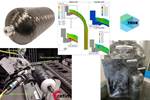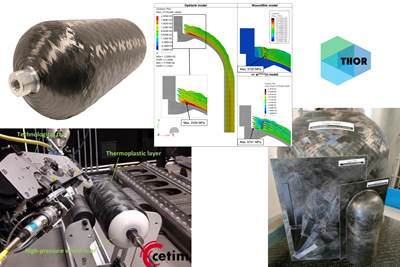FIBIAS++ project targets recycled TPC innovations for automotive applications
Project led by the IRT Jules Verne and supported by Compositec, Stellantis, IMT Nord Europe and CMO seeks to develop composites with a low CO2 footprint and recycled material incorporation.
Share
Read Next
Source (All Images) | IRT Jules Verne
(IRT Jules Verne, Bouguenais) announces the FIBIAS++ project, which has a goal to develop thermoplastic composites (TPC) based on recycled materials for use in the automotive industry, where reducing vehicle emissions and weight has become crucial.
FIBIAS++ is a collaboration between various partners. Automotive technology supplier (formerly Faurecia Composites, Saint-Malo, France) is a key player as the project aligns with the company’s net-zero emissions strategy. (Hoofddorp, Netherlands) also joins, not only for its own carbon commitments, but also to prioritize reducing vehicle weight. (Douai, France), focusing on the manufacture of PET film from recycled materials, and moldmaker CMO, are additional partners.
TPC are becoming an essential alternative to thermoset composites and metallic materials in the manufacture of automotive components, IRT Jules Verne notes, but there are still challenges. For example, can we produce a more environmentally sustainable composite, and integrate it into an environment of metal parts, while maintaining sufficient mechanical performance to meet strict safety requirements? This is the central question that FIBIAS++ is seeking to answer.
The FIBIAS++ project is the continuation of an initial research project that focused on developing technologies for processing TPC. This second phase adds an environmental dimension, with the aim of developing composites with a low CO2 footprint and incorporating recycled materials, while maintaining high performance for semi-structural, and even structural, automotive applications.
From plastic bottles to the final composite part.
In particular, project teams are working on composites such as organosheets, glass mat-reinforced thermoplastics (GMT) and sandwich structures. The major challenge is to incorporate recycled materials such as PET. However, the environmental benefits could be considerable, including reducing CO2 emissions by 50% when compared with traditional materials such as steel or thermoset composites, and lightweighting an additional 30-35% compared with metal structures.
One of the innovative aspects of FIBIAS++ is the recycling of post-consumer and post-industrial waste. IMT Nord Europe, for example, has looked at things like crushed plastic bottles for the manufacture of PET films. These recycled materials are then incorporated into TPC products or semi-finished products. IMT Nord Europe also assessed the effects of the shredding process on the performance of the materials, as the aim is to maintain optimum mechanical properties throughout the recycling cycle.
Semi-structural part.
At the same time, the IRT Jules Verne has developed a specific low-shear mixer for directly recycling composites scrap and off-cuts. This equipment mixes the waste to produce a homogeneous molten dough that can be reused by stamping or thermocompression to form finished parts or assemblies with metal parts. This innovation could be particularly promising for industrial production lines, where it would make it possible to avoid complex and costly subsequent processing of waste, while reducing transport and the costs associated with external recycling.
So far, project results are reported to be encouraging and could pave the way for the wider integration of recycled TPC in various industrial sectors. In addition, the mixer developed by the IRT could find applications in other sectors where waste management is a major issue.
Related Content
PUR composite sandwich panels for 3D automotive parts, high-volume panels and more
At its U.S. sites, Ascorium produces glass fiber/PUR 3D parts via semi-automated molding, high-volume flat panels via a continuous line while working toward bio-based PUR and recycling.
Read MoreAll-recycled, needle-punched nonwoven CFRP slashes carbon footprint of Formula 2 seat
Dallara and Tenowo collaborate to produce a race-ready Formula 2 seat using recycled carbon fiber, reducing CO2 emissions by 97.5% compared to virgin materials.
Read MoreAcciona to build wind blade recycling plant in Spain by 2025
Waste2Fiber facility will use a proprietary thermal method to separate wind blade materials for reuse and will have a processing capacity of 6,000 tons of material/year.
Read MoreDemonstrator project targets circularity solutions in carbon fiber composite sports equipment
The Carbon Fibre Circular Alliance (CFCA) brought together OEMs and technical partners to reclaim short carbon fibers from end-of-life sports equipment, realign into continuous prepreg tapes and remanufacture into new equipment.
Read MoreRead Next
Update: THOR project for industrialized, recyclable thermoplastic composite tanks for hydrogen storage
A look into the tape/liner materials, LATW/recycling processes, design software and new equipment toward commercialization of Type 4.5 tanks.
Read MorePlant tour: Collins Aerospace, Riverside, Calif., U.S. and Almere, Netherlands
Composite Tier 1’s long history, acquisition of stamped parts pioneer Dutch Thermoplastic Components, advances roadmap for growth in thermoplastic composite parts.
Read MoreMiniLab consortium produces first full-scale thermoplastic composite hydrofoils
Project advances toward first recyclable foils for ocean racing, part of “Infinite Foil” finalist for JEC Innovation Award 2025.
Read More












